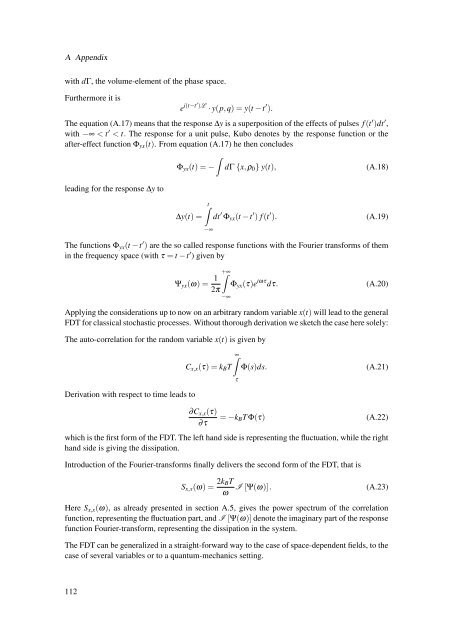Diffusion Processes with Hidden States from ... - FU Berlin, FB MI
Diffusion Processes with Hidden States from ... - FU Berlin, FB MI
Diffusion Processes with Hidden States from ... - FU Berlin, FB MI
You also want an ePaper? Increase the reach of your titles
YUMPU automatically turns print PDFs into web optimized ePapers that Google loves.
A Appendix<strong>with</strong> dΓ, the volume-element of the phase space.Furthermore it ise i(t−t′ )L · y(p,q) = y(t −t ′ ).The equation (A.17) means that the response ∆y is a superposition of the effects of pulses f (t ′ )dt ′ ,<strong>with</strong> −∞ < t ′ < t. The response for a unit pulse, Kubo denotes by the response function or theafter-effect function Φ yx (t). From equation (A.17) he then concludesˆΦ yx (t) = − dΓ {x,ρ 0 } y(t),(A.18)leading for the response ∆y toˆt∆y(t) = dt ′ Φ yx (t −t ′ ) f (t ′ ).−∞(A.19)The functions Φ yx (t −t ′ ) are the so called response functions <strong>with</strong> the Fourier transforms of themin the frequency space (<strong>with</strong> τ = t −t ′ ) given byΨ yx (ω) = 1+∞ ˆΦ yx (τ)e iωτ dτ.2π−∞(A.20)Applying the considerations up to now on an arbitrary random variable x(t) will lead to the generalFDT for classical stochastic processes. Without thorough derivation we sketch the case here solely:The auto-correlation for the random variable x(t) is given byDerivation <strong>with</strong> respect to time leads to∞ˆC x,x (τ) = k B TτΦ(s)ds.(A.21)∂C x,x (τ)∂τ= −k B T Φ(τ) (A.22)which is the first form of the FDT. The left hand side is representing the fluctuation, while the righthand side is giving the dissipation.Introduction of the Fourier-transforms finally delivers the second form of the FDT, that isS x,x (ω) = 2k BTωI [Ψ(ω)]. (A.23)Here S x,x (ω), as already presented in section A.5, gives the power spectrum of the correlationfunction, representing the fluctuation part, and I [Ψ(ω)] denote the imaginary part of the responsefunction Fourier-transform, representing the dissipation in the system.The FDT can be generalized in a straight-forward way to the case of space-dependent fields, to thecase of several variables or to a quantum-mechanics setting.112









